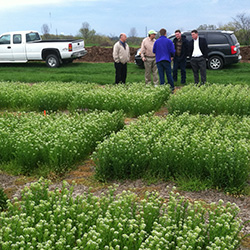
The development of techniques to enhance genetic performance represents a new era for this important crop.
About 10 years ago, the USDA National Center for Agricultural Utilization Research, known locally as the “Ag Lab,” began to work with pennycress as a potential new energy crop. While progress has been significant, recent research in molecular genetics is bringing rapid advancement to its commercialization, thus signaling a new era in pennycress development.
A Unique Winter Crop A member of the mustard family, pennycress produces more than twice the oil as soybeans, and is suitable for biodiesel or aviation fuel. What makes pennycress unique is its cropping cycle. After being planted by aerial seeding into standing corn in September, pennycress germinates; after the corn is harvested, it grows until the hard winter freeze and then goes dormant. In early spring, the crop resumes its growth, flowers and sets seed. It is harvested in late May or early June, just in time to plant full-season soybeans. Thus, farmers can produce two crops in one year, and an energy crop can be grown with no impact on the food supply.
Researchers at the Ag Lab and Western Illinois University (WIU) have been working to learn more about the basic biology of pennycress, as well as how to plant, harvest and process the seed to make biofuel. And while they were the pioneering research organizations working with pennycress, there are now many more scientists from different universities working with the crop, as its potential has clearly been demonstrated.
Like any new crop, the plants being grown today are basically wild types with no genetic improvements; most field research to date has been conducted with the “best” wild variety available. But scientists at WIU have collected samples from a number of different wild populations and found important variations in yield potential, oil content and chemistry, meaning there is great potential for genetic improvement. These scientists have begun to make selections and genetic crosses among the pennycress lines in their collection, demonstrating methods and breeding strategies that can be used to improve the new crop.
Sequencing the Pennycress Genome
Last year, while this traditional breeding strategy was underway, a research group from the University of Minnesota announced the complete sequencing of the pennycress genome, having identified all of its estimated 33,873 genes. Pennycress has many genes in common with Arabidopsis, the “lab rat” of the plant science world; thus, decades of research that have provided scientists a fundamental understanding of the metabolic functions controlled by Arabidopsis genes also offer clues to the functions of pennycress genes—and the plant traits they influence.
By using a combination of molecular biology and traditional breeding, rapid improvements in the performance traits of pennycress can be made. These traits include seed yield, oil content and composition, as well as the flowering date, which also influences the harvest date. The challenge is that many genes are involved in controlling a single trait, and all of these different traits have interactions with one another.
The Commercial Translation
To translate these basic research findings into improved genetic varieties of pennycress for commercial farming, a new company has been formed. Arvegenix LLC was established to use advanced molecular genetic information and sophisticated breeding techniques to produce commercial seeds with improved agronomic traits that bring value to farmers growing pennycress as an energy crop.
Having assembled a proprietary collection of more than 300 accessions from around the world, the company is now conducting a comprehensive genomics program that will genotype-by-sequence its collection, allowing plant breeders to quickly improve pennycress through bioinformatics, genotyping, proteomics, tissue culture and other technologies to enhance specific traits.
The development of new techniques to enhance the genetic performance of pennycress represents a new era in the history of this important crop. With new academic research teams and commercial companies working to continue these advances, progress should be rapid and exciting. iBi
Peter Johnsen was director of Peoria’s Ag Lab in the early days of pennycress research and is now involved in its commercialization.

